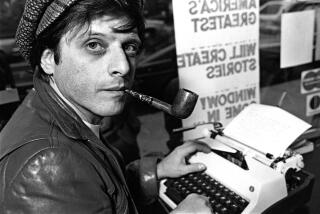Iain Sinclair walks in literary footsteps in ‘American Smoke’
Iain Sinclair has a terrific way with titles: Witness “Slow Chocolate Autopsy” (fiction), “Lights Out for the Territory” (nonfiction), “Flesh Eggs and Scalp Metal” (poetry). That these titles don’t give much away about the books’ contents is part of the deal. Sinclair is an endlessly oblique writer, erudite, edgy, sometimes allusive to the point of free association, and poetic in the broadest sense. Secret histories (usually London-based), heroes lost and found, psychogeography and epic amounts of walking, are always likely to be involved, and the result is atavistic as well as thoroughly contemporary. In some parts of the British literary world he is regarded both as avuncular tour guide and a kind of shaman.
His latest book (his 42nd by my reckoning), “American Smoke,” describes Sinclair’s investigations of his own American literary influences and enthusiasms; largely the Black Mountain poets and the Beats, from Charles Olson and Ed Dorn, to William S. Burroughs and Jack Kerouac, along with a great many acolytes and satellites. Some of these investigations involve travel to literary locales: Olson’s Gloucester, Mass., Burroughs’ Lawrence, Kan. In some cases there are face-to-face interviews — with Burroughs, Herbert Huncke and Gary Snyder, among others. Some encounters, the one with Allen Ginsberg for instance, took place as long ago as the 1960s, the most recent from road trips Sinclair took just a few years back.
One of Sinclair’s greatest skills has always been his ability to take diverse if not chaotic source material and refashion it in a way that sometimes seems downright alchemical. Once Sinclair starts making connections he finds them everywhere — gossip columnist and F. Scott Fitzgerald muse Sheilah Graham in an orphanage in south London links to Roberto Bolaño in Barcelona, who in turn links to Sinclair’s own expedition from Hastings to Hackney in a swan-shaped pedalo (a paddle boat). But what ultimately makes the book come together is Sinclair’s tough but malleable sensibility, expressed through a prose style that’s hard-edged, inventive, often wildly extravagant.
For example, discussing the Beats’ eagerness for inclusion in “the accepted lineage of modernism,” Sinclair writes, “They sniffed around each other like prowling beasts, jealous eyes on the lion tamer’s polished black boots. They listened for the crack of her whip.” And here he is describing Burroughs: “This man was a personage as remote from our experience as Homer. In newsprint and magazine photographs, he looked like a composite, a suspect Xeroxed so far from source he might be a Civil War veteran or a hard-veined Chicago exterminator in the 1920s. An alien — an alien from what?”
If you think Sinclair sometimes overcooks his prose, well, I think you may have a point, but that seems a forgivable sin. His writing is so distinctive and so singular that you have to accept it with all its eccentricities and excesses. Those eccentricities also enable him to throw fresh light on familiar themes. One more book about the Beats does not, in itself, set the pulse racing, but you know that nobody else will have a take like Sinclair’s. How many writers on the subject find it necessary to discuss Albert Speer, Adolf Hitler and the fictional cowboy Old Shatterhand?
And when all else fails, Sinclair does what any novelist might do in these circumstances: He invents things. One of the most intriguing characters in the book is Pavel Coen, a radio producer who has “a medical condition that forbids him to register anything beyond his personal space” and who travels across America with Sinclair to make a radio program, then disappears, taking the tapes with him, to write “the great Croydon novel.” And then there’s Cal Shutter, a Bay Area poet, painter, blogger and obsessive fan of British soccer. At the least these characters are highly fictionalized. Sinclair is on record as saying that Shutter “doesn’t exist.”
In the book’s penultimate chapter Sinclair arrives in Los Angeles and is seriously wrong-footed by the city, reduced to quoting his taxi driver (a no-no for even the most humble travel writer) and to observing that the place is “suspicious of pedestrians.” He sets off walking to find the “fatal bus stop” at the corner of Hollywood and Western where Malcolm Lowry “met and embraced” his future wife, but it’s unclear whether he actually gets there.
At least he finds some lost cultural history in the place he’s staying, the Sunset Tower Hotel, discovering that this is where John Wayne once kept a cow on the balcony and where Mamie Van Doren used to audition suitors. He quotes her memoir “Playing the Field,” in which she describes Burt Reynolds as “high on jive but low on substance.”
Finally, back home, Sinclair receives a letter from Cal Shutter saying, “You will never understand Americans,” and Sinclair weakly agrees, which is frankly a slap in the face for the reader after you’ve accompanied him for the last 300 pages.
In any case, they’re wrong. Sinclair understands certain things about American culture and American writing in a way that only a hyper-aware, hyper-literate and sometimes rather cranky outsider can.
Nicholson is the author of many books, including the forthcoming novel “The City Under the Skin.”
American Smoke
Journeys to the End of the Light
Iain Sinclair
Faber & Faber: 320 pp., $27
More to Read
Sign up for our Book Club newsletter
Get the latest news, events and more from the Los Angeles Times Book Club, and help us get L.A. reading and talking.
You may occasionally receive promotional content from the Los Angeles Times.








